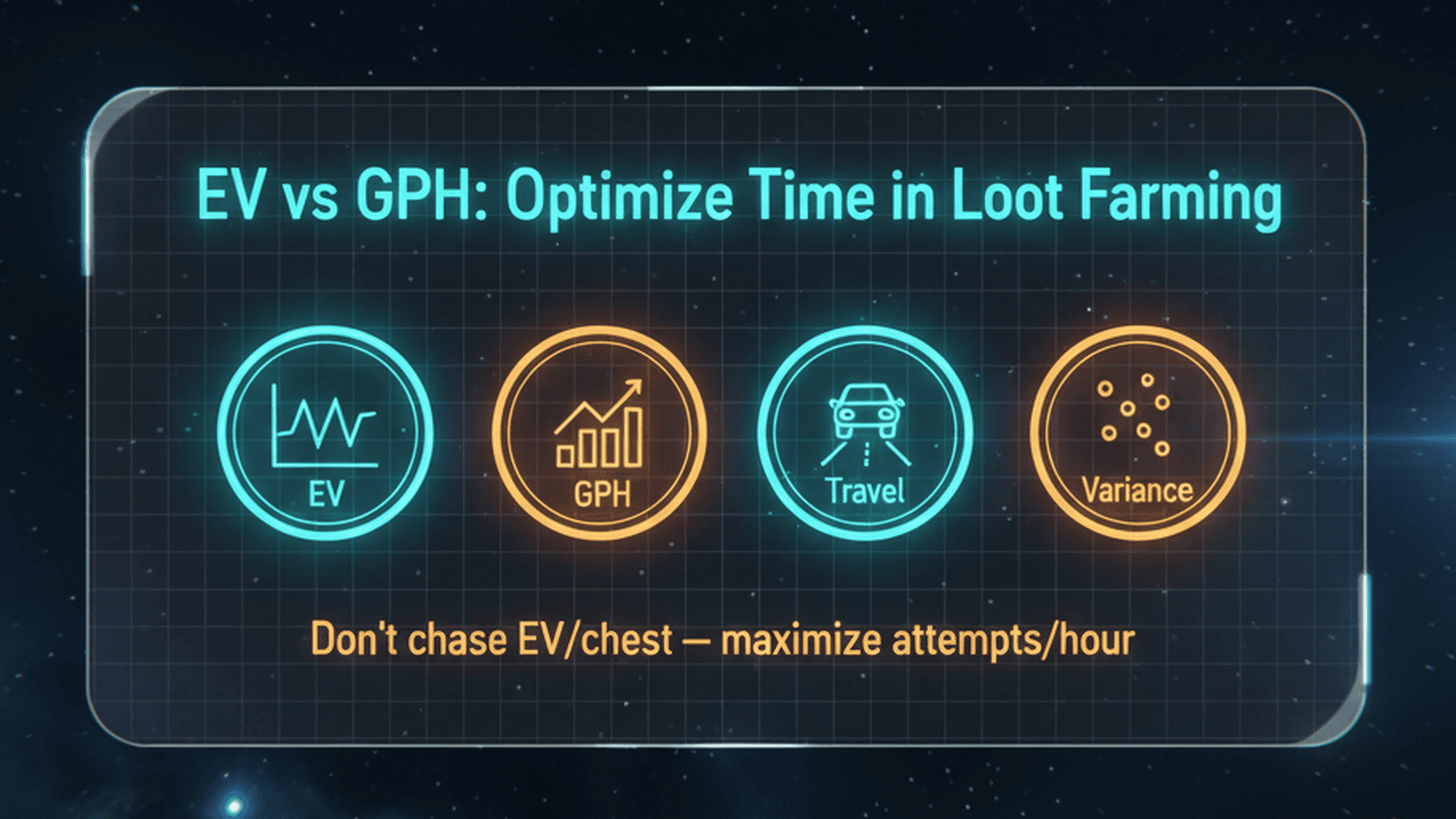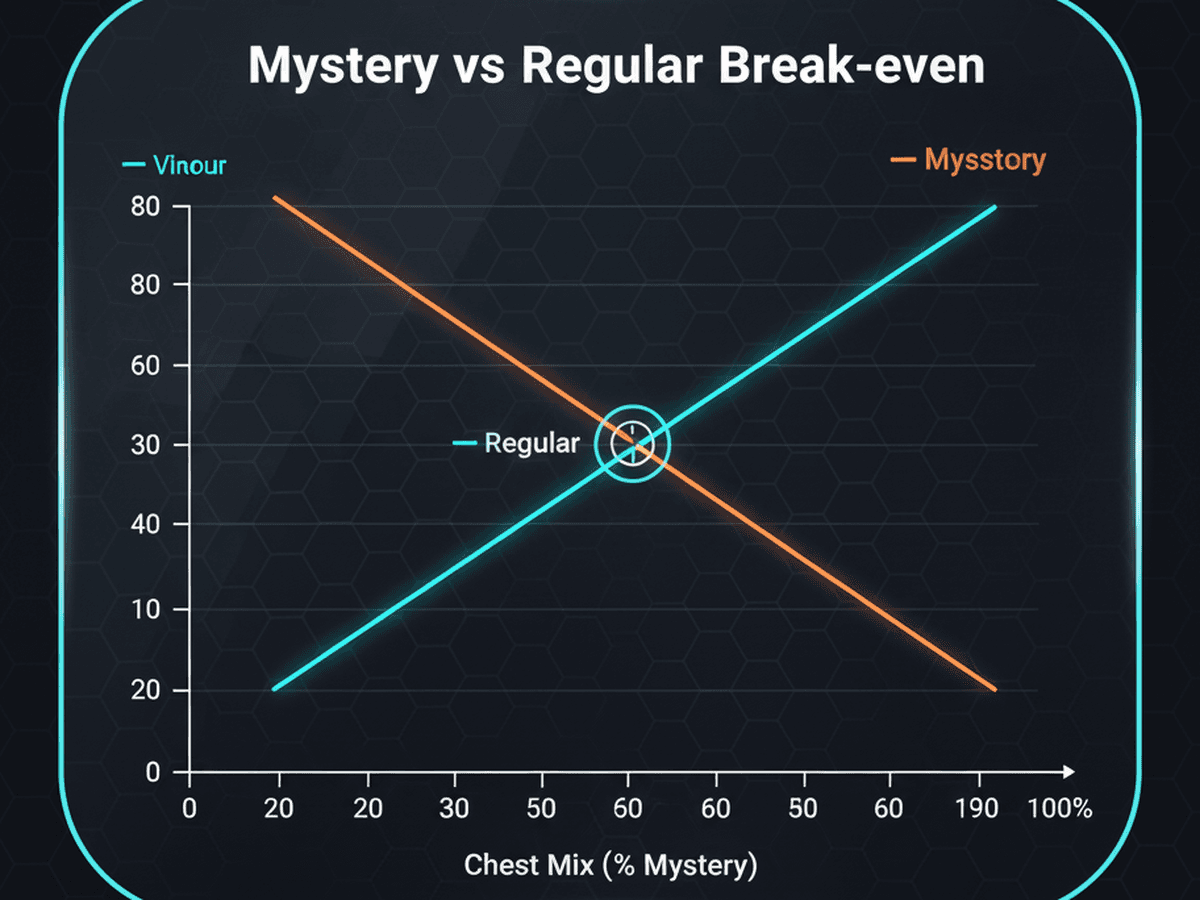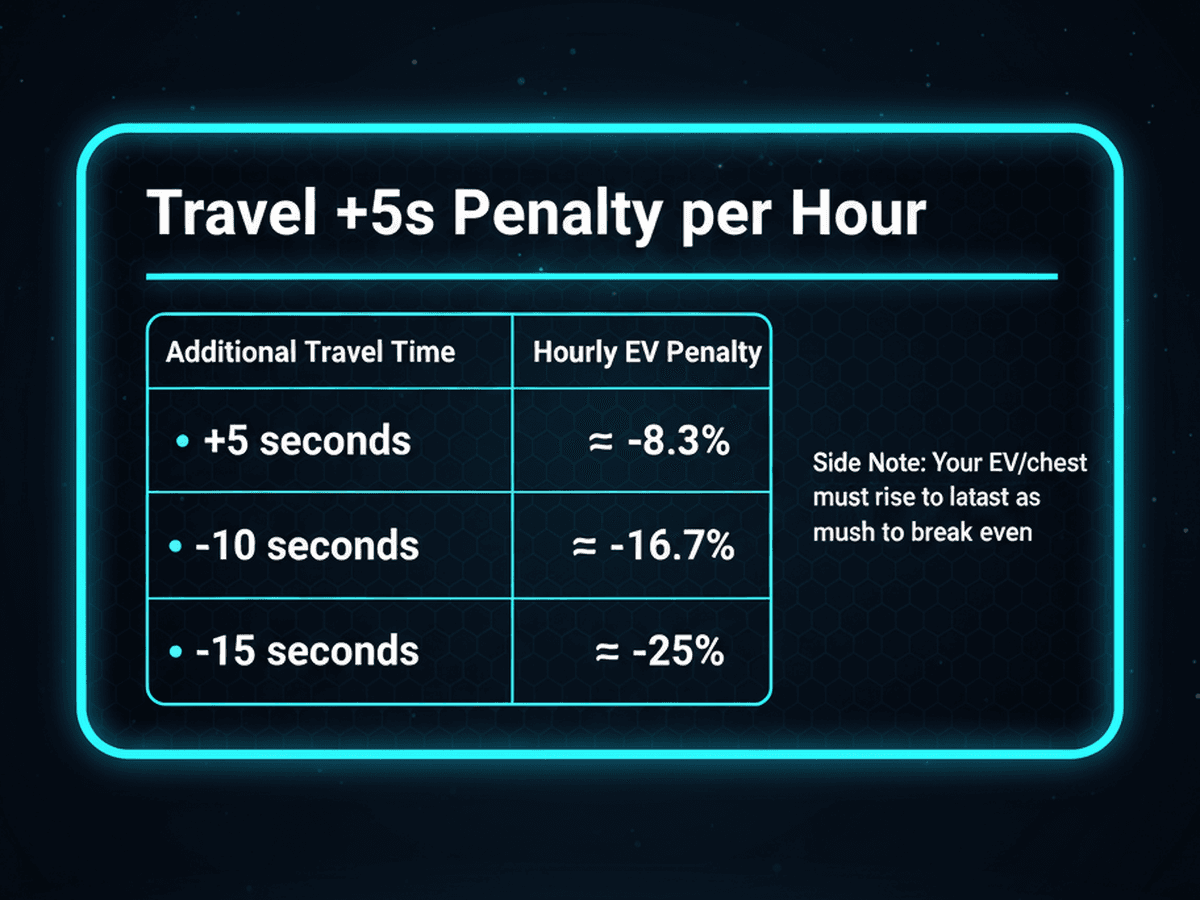EV vs GPH: Optimize Time in Loot Farming

Expected Value per hour (EV/h) and Gold per hour (GPH) are the two most critical metrics for optimizing loot farming efficiency. Whether you're running Diablo 4 Helltides, Path of Exile maps, or any ARPG endgame loop, understanding how chest mix, travel time, and resource generation interact determines your real-world gains per hour.
What Is Expected Value per Hour (EV/h)?
Expected Value (EV) measures the average loot value you expect from a single action—opening a chest, killing a boss, or completing a map. EV per hour (EV/h) extends this by accounting for how many times you can repeat that action in 60 minutes.
The Formula
EV/h = (Weighted EV per chest) × (Chests per hour)Understanding Formula Components
Where:
- Weighted EV per chest = (% Mystery chests × EVMystery) + (% Regular chests × EVRegular)
- Chests per hour = min(Cinders-limited rate, Travel-limited rate)
Rate-Limiting Factors in Helltide Farming
Your cinders-limited rate depends on resource generation speed and chest costs. Your travel-limited rate depends on movement speed, map knowledge, and downtime between chests.
Cinders-Limited Rate: Resource Generation Speed
If you farm 900 cinders/hour and each chest costs 200 cinders on average, your cinders-limited rate is 4.5 chests/hour regardless of how fast you travel.
Travel-Limited Rate: Movement and Routing Efficiency
If you can complete a chest route in 45 seconds (including looting), your travel-limited rate is 80 chests/hour regardless of how many cinders you have.
Why EV/h Matters
A chest with 200k EV that takes 3 minutes to reach gives 4,000k EV/h. A chest with 100k EV that takes 30 seconds gives 12,000k EV/h. Pure EV per chest is misleading—time is the bottleneck.
Understanding Gold per Hour (GPH)
Gold per hour (GPH) or Resources per hour measures raw currency generation. In Diablo 4 Helltides, this is cinders per hour. In other games, it might be chaos orbs, legendary shards, or gold.
The Constraint
Max chests from resources = (Resource/hour) / (Weighted cost per chest)If you generate 900 cinders/hour and your weighted chest cost is 200 cinders, you can open at most 4.5 chests/hour from resource limits alone.
Resource vs. Time Trade-off
- High GPH, slow travel: You're resource-limited. Increasing GPH or reducing chest costs helps.
- Low GPH, fast travel: You're travel-limited. Optimizing routes or reducing travel seconds helps.
Most optimized builds hit both constraints simultaneously at their break-even point—meaning every improvement to either GPH or travel time yields gains.
The Break-Even Mix: Mystery vs. Regular Chests

Cost-Efficiency Ratio
Most games offer premium chests (high EV, high cost) and budget chests (low EV, low cost). The optimal mix depends on:
Cost-efficiency (Mystery) = EV_Mystery / Cost_MysteryCost-efficiency (Regular) = EV_Regular / Cost_RegularIf Mystery chests give 150k EV for 250 cinders (600 EV/cinder) and Regular chests give 70k EV for 75 cinders (933 EV/cinder), Regular chests are more cost-efficient.
Why You Still Want Some Mystery Chests
Even when Regular chests are more cost-efficient, Mystery chests have higher absolute EV. If you're travel-limited (finishing routes with leftover cinders), spending those cinders on Mystery chests maximizes value.
The Sweet Spot
The chart above shows how EV/h peaks around 60-80% Mystery chests in typical Diablo 4 Helltide scenarios. Too many Mystery chests wastes time. Too few wastes the high EV potential.
Try our interactive calculator: Diablo 4 Helltide Loot Calculator
Travel Time Sensitivity Analysis

How Travel Seconds Impact EV/h
Every second spent traveling between chests reduces your effective chests/hour:
Chests/hour (travel-limited) = 3600 / (Travel seconds per chest)At 30 seconds travel, you can open 120 chests/hour. At 60 seconds, only 60 chests/hour—a 50% loss.
The Diminishing Returns Curve
The chart above shows steep EV/h losses from 30→60 seconds, but flatter losses from 60→90 seconds. This is because once you're travel-limited, incremental travel reductions have diminishing impact.
When to Prioritize Speed
- Fast routes (≤45s): Resource-limited. Focus on GPH or chest cost reduction.
- Slow routes (≥60s): Travel-limited. Invest in movement speed, teleports, or better routing.
- Balanced routes (45-60s): Both matter equally—optimize both simultaneously.
Route Optimization Strategies by Travel Time
Fast Route Optimization (Under 45 Seconds)
When routes are fast, you finish with time to spare but run out of cinders. Prioritize increasing your cinders/hour through better mob farming, event participation, or Helltide farming buffs.
Slow Route Optimization (Over 60 Seconds)
When routes are slow, you finish with leftover cinders but waste time traveling. Focus on movement speed (mount upgrades, teleport cooldowns), route planning, and skipping distant chests.
Movement Speed Improvements for Travel-Limited Farms
Invest in mount speed upgrades, evade cooldown reduction, and teleport abilities. A 10% movement speed increase reduces 60-second routes to 54 seconds, yielding 11% more chests/hour.
Route Planning Tips for Maximum Efficiency
Identify chest clusters on the map. Prioritize tight loops with 3-4 chests within 20 seconds of each other. Avoid crossing the entire map for a single chest unless you have excess cinders.
Advanced: The Two-Constraint Model

Dual Bottleneck System
Your effective chests/hour is always the minimum of:
- Cinders-limited: GPH / weighted cost
- Travel-limited: 3600 / travel seconds
Effective chests/hour = min(Cinders-limited, Travel-limited)Identifying Your Bottleneck
- If Cinders-limited < Travel-limited: You finish routes with time to spare. Improve GPH or reduce chest costs.
- If Travel-limited < Cinders-limited: You finish routes with leftover cinders. Improve travel speed or routing.
- If Cinders-limited ≈ Travel-limited: You're perfectly balanced. Any improvement helps.
Optimization Strategies by Constraint
| Constraint | Problem | Solutions |
|---|---|---|
| Resource-limited | Too slow GPH | Farm more efficiently, use GPH buffs, reduce chest costs |
| Travel-limited | Routes too slow | Better routing, movement speed, mount upgrades |
| Balanced | Both constraints active | Improve both—every 10% gain in either yields 10% EV/h |
Real-World Example: Diablo 4 Helltide Season 4
Starting Assumptions
- Cinders/hour: 900
- Travel time: 45 seconds per chest
- Mystery chest: 150k EV, 250 cinders
- Regular chest: 70k EV, 75 cinders
- Mix: 70% Mystery, 30% Regular
Step 1: Calculate Weighted Cost and EV
Weighted cost = 0.70 × 250 + 0.30 × 75 = 175 + 22.5 = 197.5 cindersWeighted EV = 0.70 × 150k + 0.30 × 70k = 105k + 21k = 126kBreaking Down the Weighted Calculation
Weighted Cost Formula for Chest Mix
The weighted cost represents the average cinders spent per chest based on your mix. With 70% Mystery (250 cinders) and 30% Regular (75 cinders), you spend 197.5 cinders on average per chest opened.
Weighted EV Formula for Loot Value
Similarly, weighted EV is the average loot value per chest. At 70% Mystery (150k EV) and 30% Regular (70k EV), each chest yields 126k gold on average.
Mystery Chest EV Contribution to Total
Mystery chests contribute 70% × 150k = 105k to the weighted EV. This represents 83.3% of your total expected value despite being only 70% of your opens.
Regular Chest EV Contribution to Total
Regular chests contribute 30% × 70k = 21k to the weighted EV. While they are 30% of opens, they provide only 16.7% of total value, but use fewer cinders.
Step 2: Find Both Limits
Cinders-limited = 900 / 197.5 = 4.56 chests/hourTravel-limited = 3600 / 45 = 80 chests/hourBottleneck: Cinders-limited (4.56 < 80) — you're resource-starved, not time-starved.
Step 3: Calculate EV/h
Effective chests/hour = 4.56EV/h = 126k × 4.56 = 574,560 ≈ 575k/hourStep 4: Test Optimizations
Option A: Increase GPH to 1,200 cinders/hour
New cinders-limited = 1200 / 197.5 = 6.08 chests/hourNew EV/h = 126k × 6.08 = 766k/hour (+33%)GPH Optimization Impact on Resource-Limited Builds
Increasing cinders/hour from 900 to 1,200 (+33%) directly translates to 33% more EV/hour when you are resource-limited. This is the most effective optimization for fast routes.
Option B: Reduce travel to 30 seconds
Travel-limited = 3600 / 30 = 120 chests/hourStill cinders-limited at 4.56, so EV/h unchanged (+0%)Travel Speed Optimization Impact on Cinders-Limited Builds
Reducing travel time has zero impact when you are resource-limited. Your bottleneck is cinders, not time. Travel optimizations only help once you increase GPH enough to become travel-limited.
When Travel Optimization Starts Mattering
Travel optimization becomes valuable once your cinders-limited rate exceeds your travel-limited rate. In this example, you would need to increase GPH to approximately 1,580 cinders/hour (travel-limited = 80 chests/hour × 197.5 cost = 15,800 cinders/hour ÷ 10 for hourly math).
Conclusion: When resource-limited, improving GPH yields gains. Improving travel time does nothing until you hit the travel constraint.
Practical Takeaways
1. Measure Both Constraints
Never optimize blindly. Calculate your cinders-limited and travel-limited rates. Improve whichever is lower.
2. Aim for Balance
The most efficient farms have both constraints nearly equal. A 900 GPH build with 45s travel is resource-limited. A 1,800 GPH build with 90s travel is travel-limited. A 1,200 GPH build with 60s travel is balanced.
3. Mystery Chests Aren't Always Best
Even when Mystery chests have higher EV, Regular chests can be more cost-efficient. Use a mix based on your resource constraint, not just raw EV.
4. Travel Time Is Exponential
Reducing travel from 60s → 45s (+25% speed) gives 33% more chests/hour when travel-limited. Reducing 30s → 22.5s gives 33% more again. Every percentage point matters.
5. Use a Calculator
Mental math breaks down with weighted costs and dual constraints. Use tools like our Diablo 4 Helltide Loot Calculator to test scenarios instantly.
Additional Resources
- Interactive Calculator: Diablo 4 Helltide Loot Calculator — adjust GPH, travel time, chest mix, and see results instantly
- WoW Delves Guide: WoW Delves EV & GPH Analysis — similar principles applied to WoW endgame
- CSV Export: Download your calculated data for custom analysis
Conclusion
Optimizing loot farming isn't about opening the most chests or farming the highest EV content—it's about maximizing Expected Value per hour by balancing resource generation (GPH) and time efficiency (travel seconds). Understanding the two-constraint model lets you diagnose bottlenecks instantly and apply the right fix.
Whether you're running Helltides, Delves, or any other ARPG endgame loop, the math is the same: measure both constraints, optimize the bottleneck, and aim for balance.
Try the Interactive Calculator
Test different scenarios with our live Diablo 4 Helltide calculator. Adjust cinders/hour, travel time, and chest mix to see instant EV/h results.
Open Calculator →Related Articles & Calculators
Drop Math: EV, Union Probability & Binomial
Comprehensive guide to the mathematical foundations of loot farming
Diablo 4 Helltide Calculator
Apply these concepts with real-time EV/hour calculations
WoW Delves Calculator
Calculate vault thresholds and weekly rewards with EV optimization
OSRS Barrows Calculator
Optimize your Barrows runs with EV and P(any) calculations